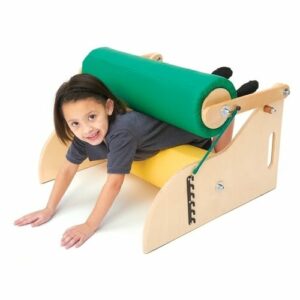Deep pressure therapy is a type of sensory processing intervention that is often used to help people with ADHD. It involves applying pressure to the body in a strategic way in order to stimulate the senses. This can be done through various methods, such as massage, weighted blankets, and deep touch pressure devices. In this blog post, we will discuss what deep pressure therapy is and how it can help people with ADHD!
Contents
- 1 What Is Deep Pressure Therapy?
- 2 How Does Deep Pressure Therapy For ADHD Work?
- 3 What Techniques Are Used In Deep Pressure Therapy For ADHD?
- 4 What Are Deep Pressure Calming Activities?
- 5 What Are The Benefits Of Deep Pressure Therapy For ADHD?
- 6 How Can I Do Deep Pressure Therapy For ADHD At Home?
- 7 Conclusion
What Is Deep Pressure Therapy?
 Deep pressure therapy is a treatment technique that involves applying pressure to the body using hands, tools, or machines to help people relax and manage stress. It can be used as part of occupational therapy, physical therapy, massage therapy, and other treatments for mental health conditions such as anxiety, depression, and autism spectrum disorder.
Deep pressure therapy is a treatment technique that involves applying pressure to the body using hands, tools, or machines to help people relax and manage stress. It can be used as part of occupational therapy, physical therapy, massage therapy, and other treatments for mental health conditions such as anxiety, depression, and autism spectrum disorder.
Deep pressure therapy has been found to be effective in reducing levels of the hormone cortisol—which is associated with stress and anxiety. Several studies have shown that deep-pressure therapy can have a positive effect on mental and physical health.
This therapy is not intended to replace medical treatment or be used in place of psychological treatments. In fact, it should only be used as an adjunct to other forms of care under the guidance of a qualified professional.
How Does Deep Pressure Therapy For ADHD Work?
As this therapy seems to be effective for treating ADHD, the exact mechanism of deep pressure therapy is not clear. However, one theory suggests that it works by providing sensory input to the body in a way that helps to regulate behavior and emotions.
By providing tactile stimulation, such as squeezing or hugging, is thought to activate the parasympathetic nervous system. That slows down the body’s response to stress, allowing the person to focus and concentrate better. This helps with regulating emotions and calming down hyperactivity.
Another theorized effect of deep-pressure therapy is that it can help people with ADHD to organize their thoughts and behavior. This could be because the tactile input helps the person to become more aware of their body and surroundings, allowing them to better control their responses.
What Techniques Are Used In Deep Pressure Therapy For ADHD?
The following are some of the techniques used in deep-pressure therapy for ADHD:
1. Deep Touch Pressure (DTP): This technique involves applying firm, sustained pressure to key areas of the body such as the back, legs, and arms. The purpose of this is to help reduce stress levels and stimulate serotonin production, which can help improve impulse control and attention.
2. Massage Therapy: Massage therapy is a form of deep-pressure therapy that can help reduce anxiety, boost mood, and improve concentration. It can also work to reduce tension in the muscles and encourage relaxation.
3. Meditation: Meditating is another way to experience deep-pressure therapy. This type of therapy encourages mindfulness and helps to lower levels of stress hormones.
4. Yoga: While yoga is traditionally known as being a stretching exercise, it can also be used as a form of deep-pressure therapy. Certain poses in yoga are designed to help release tension and reduce overall stress levels in the body, which helps with ADHD symptoms.
5. Acupuncture: Acupuncture has been used for centuries to treat a number of conditions, and it can also be used as a form of deep-pressure therapy for ADHD. It works by helping to stimulate the body’s natural healing processes and reduce stress levels.
By incorporating these various techniques into your treatment plan, you can help reduce symptoms associated with ADHD. Deep-pressure therapy can be a powerful tool in managing ADHD. And is often recommended as part of an overall treatment plan.
What Are Deep Pressure Calming Activities?
 It is important to understand what deep pressure calming activities are before beginning them. These activities involve using pressure to promote relaxation and reduce stress and anxiety. These activities typically include:
It is important to understand what deep pressure calming activities are before beginning them. These activities involve using pressure to promote relaxation and reduce stress and anxiety. These activities typically include:
- Pushups: This exercise is often used in the traditional sense to build strength, but can also be done as a calming activity. Pushups involve pushing your body up and down with your arms and legs while maintaining proper form. This helps to release tension and help you relax.
- Situps: This exercise is similar to pushups in that it involves using your arms and legs for resistance. However, with situps, you are lying down on your back and lifting up into a sitting position. It helps to focus on breathing and can be a great way to reduce stress and anxiety.
- Squeezing: Squeezing can be used to relieve stress and anxiety. It is done by firmly squeezing your hands together or using a grip ball, and can help you to focus on the feeling of pressure rather than whatever may be causing your stress or anxiety.
- Jumping jacks: Jumping jacks are another exercise that can be used to reduce stress and increase relaxation. They involve jumping up and down with your arms and legs while keeping your core engaged. This helps to release tension in the body and can help you feel calmer.
- Hugs/cuddles: Hugging or cuddling someone else is a great way to relax and reduce stress. Physical contact helps to release oxytocin, a hormone that reduces anxiety and helps you feel more relaxed. It also has the benefit of providing emotional support which can be very beneficial in reducing stress.
Deep pressure calming activities are beneficial for ADHD, anxiety, and depression. They can help to reduce stress and improve mood by providing an outlet for physical tension. They also give the individual a sense of control over their body which can help them focus on more positive activities and thoughts.
What Are The Benefits Of Deep Pressure Therapy For ADHD?
There are numerous benefits of deep pressure therapy for ADHD, including:
1. Improved Focus and Concentration: Deep pressure therapy helps to reduce distractions and enhances focus and concentration in children with ADHD by calming the nervous system. It can also help to improve executive functioning skills such as working memory, organization, planning, and problem-solving.
2. Improved Self-Regulation: This also helps to regulate arousal levels and improve behavior. It can also reduce impulsive behaviors, hyperactivity, and restlessness which are common symptoms of ADHD.
3. Reduced Stress and Anxiety: One of the vital benefits of deep-pressure therapy for ADHD is its ability to reduce stress and anxiety. It can help children calm down and regulate their emotions, helping them cope with difficult situations in a more manageable way.
4. Improved Sleep: It seems very logical, but deep-pressure therapy has been found to help improve sleep in children with ADHD. This is because it helps the body relax and encourages a regular sleep cycle.
5. Improved Social Skills: Lastly, deep pressure therapy also helps improve social skills by calming the nervous system and improving self-control and impulse regulation in children with ADHD. This helps children be able to better interact with peers and manage social situations more effectively.
Overall, deep pressure therapy is a safe, non-invasive treatment that can provide significant benefits for those who suffer from ADHD. Regular use can actually be a great way to manage symptoms of ADHD naturally. So, if you are looking for an alternative to traditional treatments, deep pressure therapy may be just the thing you need!
How Can I Do Deep Pressure Therapy For ADHD At Home?
 If you’re looking to practice deep-pressure therapy for ADHD at home, there are a few things you can do.
If you’re looking to practice deep-pressure therapy for ADHD at home, there are a few things you can do.
First, it’s important to understand the proper technique. Deep pressure should be applied evenly and consistently using your hands or gentle objects like a softball or stuffed animal. You should start by applying light pressure and gradually increasing the intensity as you work.
You can also invest in a deep-pressure vest, which has been designed to provide the same calming effects as the hands-on technique. The vests come with adjustable straps that allow you to control the intensity of pressure and target certain areas of your body more effectively.
Another great option is weighted blankets, which are especially beneficial for people who have sensory processing issues. The weight of the blanket helps to provide a soothing and calming sensation, which can help to reduce stress, improve focus, and promote relaxation.
Finally, there are plenty of online resources available that will teach you how to practice deep-pressure therapy at home. Many websites offer step-by-step instructions and videos that can help you get started. There are even some programs that offer virtual coaching to help ensure you’re performing the techniques correctly.
Regardless of which method you choose, it’s important to practice regular deep-pressure sessions in order for them to be successful. Surely, you will be able to see improvements in your behavior and attention span with consistent, regular practice. With a bit of patience and dedication, you can find success in deep-pressure therapy for ADHD at home.
Conclusion
In conclusion, deep pressure therapy for ADHD is widely studied and mostly found to be effective in managing symptoms and behaviors. Despite this, it is important for parents to consult with a professional once. Before using deep-pressure therapy as a form of treatment for ADHD. Additionally, due to the potential risks associated with it, you should be administered in moderation and supervised at all times.
However, this is only one form of treatment and it is important to consider that there are a variety of other treatments available for ADHD. It is essential to explore different methods and consult with a professional to determine the best course of action for yourself.
For more information, please contact MantraCare. ADHD is a neurodevelopmental disorder characterized by difficulty in paying attention, hyperactivity, and impulsivity. If you have any queries regarding Online ADHD Counseling experienced therapists at MantraCare can help: Book a trial ADHD therapy session


